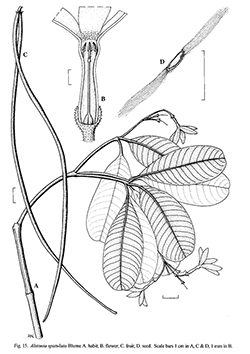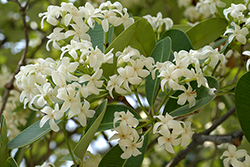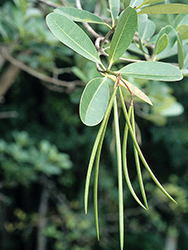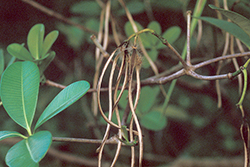e-Flora of Thailand
Volume 7 > Part 1 > Year 1999 > Page 46 > Apocynaceae > Alstonia
7. Alstonia spatulata Blumewfo-0000953059
Bijdr. 1037. 1826; Hook.f., Fl. Br. Ind. 3: 642. 1882; King & Gamble, J. As. Soc. Beng. 74(2): 437. 1907; Ridl., Fl. Malay Penins. 2: 346. 1923; Pitard, Fl. Gen I.-C. 3: 1165. 1933; Kerr, Fl. Siam. En. 2: 441. 1939; Corner, Ways. Trees 142. 1940; Monachino, Pac. Sci. 3: 153. 1949; Backer & Bakh.f., Fl. Java 2: 226. 1965; Whitmore, Tree Fl. Mal. 2: 8, 1973; Markgr., Blumea 22: 25. 1974; Lý, Fedd. Rep. 97: 612. 1986. Fig. 15.
Accepted Name : This is currently accepted.
Synonyms & Citations :
Description : Small tree to 5–10 m tall, rarely to 30 m tall; larger trees fluted or buttressed at base. Bark grey, inner bark pale yellow, sapwood white. Branches glabrous; sparsely lenticellate or not. Leaves in whorls of 3–5; blade coriaceous, spathulate, 2.5–11 x 0.8–5 cm, apex rounded or retuse, base decurrent; secondary veins 21–35 pairs, close together, straight; glabrous; glands in the axils. Inflorescence 5.8–9 cm long; lax, glabrous, many flowered; pedicels 3.5–10 mm long. Sepals ovate, 2 x 1.2–1.3 mm, apex obtuse or rounded; glabrous, ciliate. Corolla white; lobes overlapping to the left in bud; tube 6–9 mm long; lobes 6.5–9 x 3–4.5 mm, oblong, apex rounded; glabrous outside, densely pubescent inside except at base of tube. Stamens inserted in upper half of tube; anthers 1–1.1 x 0.4–0.6 mm. Disk absent or very short. Ovary of 2 carpels, glabrous, 0.9–1.2 mm long; style + pistil head 4.9–6.4 mm long. Fruit a pair of follicles; 11.8–24 cm long, 2.2–3 mm wide; glabrous; many seeded. Seeds surface glabrous; oblong, ends rounded; ca 5 x 1 mm; cilia ca 1 mm long.
Thailand : PENINSULAR: Nakhon Si Thammarat, Trang, Songkhla, Pattani, Narathiwat.
Distribution : Vietnam, Cambodia, Malaysia, Indonesia (type from Java).
Ecology : Along the edge of peat swamp forests
Vernacular : Sia (เซียะ), tinpet phru (ตีนเป็ดพรุ), thia (เทียะ)(Peninsular).
Uses: The wood is similar to Alstonia angustiloba and the latex has been reported to be of medicinal use on sores and skin diseases.




